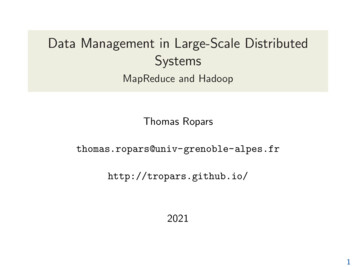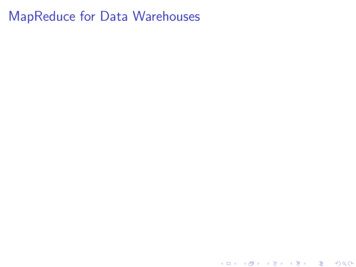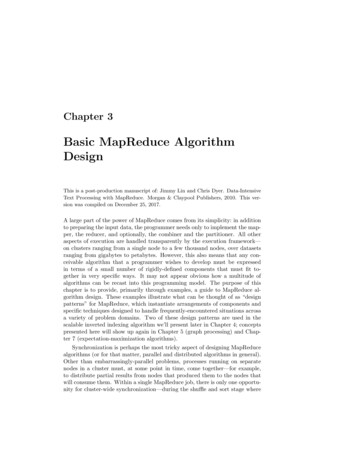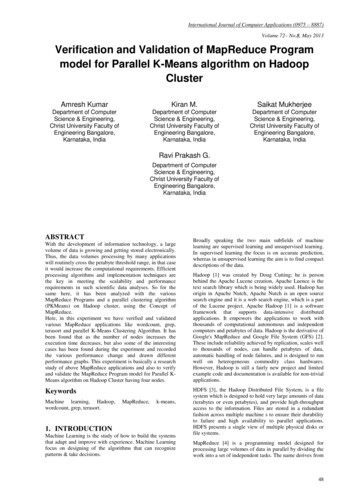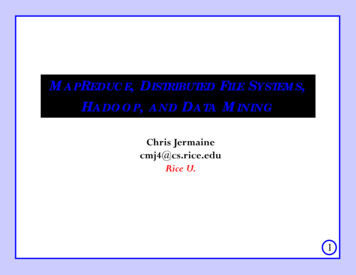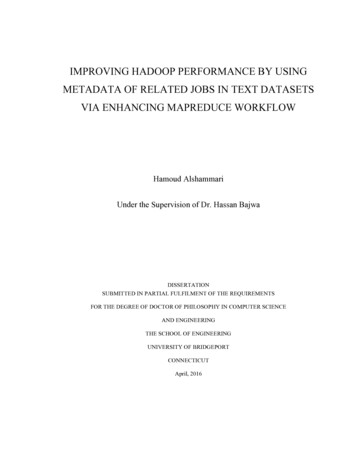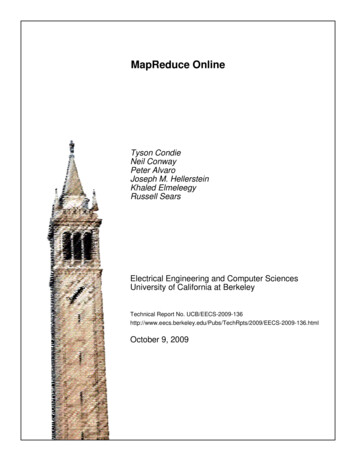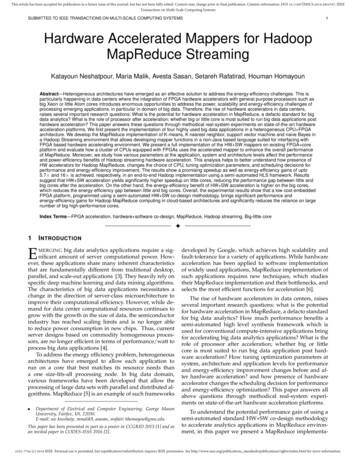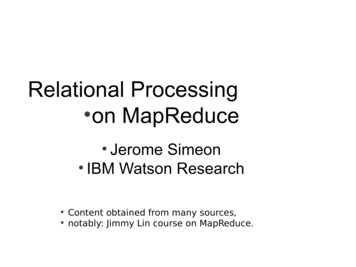
Transcription
Relational Processing on MapReduce Jerome Simeon IBM Watson Research Content obtained from many sources, notably: Jimmy Lin course on MapReduce.
Our Plan Today1. Recap:– Key relational DBMS notes– Key Hadoop notes2. Relational Algorithms on MapReduce– How to do a select, groupby, join etc3. Queries on MapReduce: Hive and Pig
Big Data Analysis Peta-scaledatasets are everywhere: Facebookhas 2.5 PB of user data 15 TB/day (4/2009) eBay has 6.5 PB of user data 50 TB/day (5/2009) A lotof these datasets have some structure Querylogs Point-of-sale records User data (e.g., demographics) Howdo we perform data analysis at scale? Relationaldatabases and SQL MapReduce (Hadoop)
Relational Databases vs. MapReduce Relationaldatabases: Multipurpose:analysis and transactions; batch and interactive Data integrity via ACID transactions Lots of tools in software ecosystem (for ingesting, reporting, etc.) Supports SQL (and SQL integration, e.g., JDBC) Automatic SQL query optimization MapReduce(Hadoop): Designedfor large clusters, fault tolerant Data is accessed in “native format” Supports many query languages Programmers retain control over performance Open sourceSource: O’Reilly Blog post by Joseph Hellerstein (11/19/2008)
Database Workloads OLTP(online transaction processing) Typicalapplications: e-commerce, banking, airline reservations User facing: real-time, low latency, highly-concurrent Tasks: relatively small set of “standard” transactional queries Data access pattern: random reads, updates, writes (involvingrelatively small amounts of data) OLAP(online analytical processing) Typicalapplications: business intelligence, data mining Back-end processing: batch workloads, less concurrency Tasks: complex analytical queries, often ad hoc Data access pattern: table scans, large amounts of data involved perquery
One Database or Two? Downsidesof co-existing OLTP and OLAP workloads Poormemory management Conflicting data access patterns Variable latency Solution:separate databases User-facingOLTP database for high-volume transactions Data warehouse for OLAP workloads How do we connect the two?
OLTP/OLAP ArchitectureETLOLTP(Extract, Transform, and Load)OLAP
OLTP/OLAP Integration OLTPdatabase for user-facing transactions Retainrecords of all activity Periodic ETL (e.g., nightly) Extract-Transform-Load(ETL) Extractrecords from source Transform: clean data, check integrity, aggregate, etc. Load into OLAP database OLAPdatabase for data warehousing Businessintelligence: reporting, ad hoc queries, data mining, etc. Feedback to improve OLTP services
Business Intelligence Premise:more data leads to better business decisions Periodicreporting as well as ad hoc queries Analysts, not programmers (importance of tools and dashboards) Examples: Slicing-and-dicingactivity by different dimensions to betterunderstand the marketplace Analyzing log data to improve OLTP experience Analyzing log data to better optimize ad placement Analyzing purchasing trends for better supply-chain management Mining for correlations between otherwise unrelated activities
OLTP/OLAP Architecture: Hadoop?What about here?ETLOLTP(Extract, Transform, and Load)Hadoop here?OLAP
OLTP/OLAP/Hadoop ArchitectureETLOLTP(Extract, Transform, and Load)HadoopWhy does this make sense?OLAP
ETL Bottleneck Reportingis often a nightly task: ETLis often slow: why? What happens if processing 24 hours of data takes longer than 24hours? Hadoop Mostis perfect:likely, you already have some data warehousing solution Ingest is limited by speed of HDFS Scales out with more nodes Massively parallel Ability to use any processing tool Much cheaper than parallel databases ETL is a batch process anyway!
MapReduce: Recap Programmersmust specify:map (k, v) k’, v’ *reduce (k’, v’) k’, v’ * All values with the same key are reduced together Optionally,also:partition (k’, number of partitions) partition for k’ Often a simple hash of the key, e.g., hash(k’) mod n Divides up key space for parallel reduce operationscombine (k’, v’) k’, v’ * Mini-reducers that run in memory after the map phase Used as an optimization to reduce network traffic Theexecution framework handles everything else
k1 v1 k2 v2 k3 v3 k4 v4 k5 v5 k6 v6mapa 1mapb 2c 3combinea 1mapc 6a 5combineb 2c 2b 7combinec 9partitionmapa 5partitioncombinec 2b 7partition1 5b2 7c 8partitionShuffle and Sort: aggregate values by keysac 8c2 9 8reducereducereducer1 s1r2 s2r3 s3
“Everything Else” Theexecution framework handles everything else Scheduling:assigns workers to map and reduce tasks “Data distribution”: moves processes to data Synchronization: gathers, sorts, and shuffles intermediate data Errors and faults: detects worker failures and restarts Limited All Youcontrol over data and execution flowalgorithms must expressed in m, r, c, pdon’t know: Wheremappers and reducers run When a mapper or reducer begins or finishes Which input a particular mapper is processing Which intermediate key a particular reducer is processing
MapReduce algorithmsfor processing relational data
Design Pattern: Secondary Sorting MapReduce Values What E.g.,sorts input to reducers by keyare arbitrarily orderedif want to sort value also?k (v1, r), (v3, r), (v4, r), (v8, r)
Secondary Sorting: Solutions Solution1: Buffervalues in memory, then sort Why is this a bad idea? Solution2: “Value-to-keyconversion” design pattern: form compositeintermediate key, (k, v1) Let execution framework do the sorting Preserve state across multiple key-value pairs to handle processing Anything else we need to do?
Value-to-Key ConversionBeforek (v1, r), (v4, r), (v8, r), (v3, r) Values arrive in arbitrary order After(k, v1) (v1, r)(k, v3) (v3, r)(k, v4) (v4, r)(k, v8) (v8, r) Values arrive in sorted order Process by preserving state across multiple keysRemember to partition correctly!
Working Scenario Twotables: Userdemographics (gender, age, income, etc.) User page visits (URL, time spent, etc.) Analyses Statisticswe might want to perform:on demographic characteristics Statistics on page visits Statistics on page visits by URL Statistics on page visits by demographic characteristic
Relational Algebra Primitives Projection(π) Selection (σ) Cartesian product ( ) Set union ( ) Set difference ( ) Rename (ρ) Otheroperations( ) Group by aggregation Join
ProjectionR1R1R2R2R3R3R4R4R5R5
Projection in MapReduce Easy! Mapover tuples, emit new tuples with appropriate attributes No reducers, unless for regrouping or resorting tuples Alternatively: perform in reducer, after some other processing Basically Speedlimited by HDFS streaming speedsof encoding/decoding tuples becomes important Relational databases take advantage of compression Semistructured data? No problem!
SelectionR1R2R1R3R3R4R5
Selection in MapReduce Easy! Mapover tuples, emit only tuples that meet criteria No reducers, unless for regrouping or resorting tuples Alternatively: perform in reducer, after some other processing Basically Speedlimited by HDFS streaming speedsof encoding/decoding tuples becomes important Relational databases take advantage of compression Semistructured data? No problem!
Group by Aggregation Example: InSQL: SELECT InWhat is the average time spent per URL?url, AVG(time) FROM visits GROUP BY urlMapReduce: Mapover tuples, emit time, keyed by url Framework automatically groups values by keys Compute average in reducer Optimize with combiners
Relational JoinsSource: Microsoft Office Clip Art
Relational JoinsR1S1R2S2R3S3R4S4R1S2R2S4R3S1R4S3
Types of RelationshipsMany-to-ManyOne-to-ManyOne-to-One
Join Algorithms in MapReduce Reduce-sidejoin Map-side join In-memory join Stripedvariant Memcached variant
Reduce-side Join Basicidea: group by join key Mapover both sets of tuples Emit tuple as value with join key as the intermediate key Execution framework brings together tuples sharing the same key Perform actual join in reducer Similar to a “sort-merge join” in database terminology Twovariants 1-to-1joins 1-to-many and many-to-many joins
Reduce-side Join: sR1S2S3R4Note: no guarantee if R is going to come first or S
Reduce-side Join: luesR1S2S3What’s the problem?
Reduce-side Join: V-to-K ConversionIn reducer keysvaluesR1S2New key encountered: hold in memoryCross with records from other setS3S9R4S3S7New key encountered: hold in memoryCross with records from other set
Reduce-side Join: many-to-manyIn reducer keysvaluesR1R5Hold in memoryR8S2Cross with records from other setS3S9What’s the problem?
Map-side Join: Basic IdeaAssume two datasets are sorted by the join key:R1S2R2S4R4S3R3S1A sequential scan through both datasets to join(called a “merge join” in database terminology)
Map-side Join: Parallel Scans Ifdatasets are sorted by join key, join can be accomplishedby a scan over both datasets How can we accomplish this in parallel? Partition Inand sort both datasets in the same mannerMapReduce: Mapover one dataset, read from other corresponding partition No reducers necessary (unless to repartition or resort) Consistentlypartitioned datasets: realistic to expect?
In-Memory Join Basicidea: load one dataset into memory, stream overother dataset Worksif R S and R fits into memory Called a “hash join” in database terminology MapReduce DistributeimplementationR to all nodes Map over S, each mapper loads R in memory, hashed by join key For every tuple in S, look up join key in R No reducers, unless for regrouping or resorting tuples
In-Memory Join: Variants Stripedvariant: Rtoo big to fit into memory? Divide R into R1, R2, R3, s.t. each Rn fits into memory Perform in-memory join: n, Rn S Take the union of all join results Memcached Loadjoin:R into memcached Replace in-memory hash lookup with memcached lookup
MemcachedCaching servers: 15 million requests per second,95% handled by memcache (15 TB of RAM)Database layer: 800 eight-core Linux serversrunning MySQL (40 TB user data)Source: Technology Review (July/August, 2008)
Memcached Join Memcachedjoin: LoadR into memcached Replace in-memory hash lookup with memcached lookup Capacityand scalability? Memcachedcapacity RAM of individual node Memcached scales out with cluster Latency? Memcachedis fast (basically, speed of network) Batch requests to amortize latency costsSource: See tech report by Lin et al. (2009)
Which join to use? In-memoryjoin map-side join reduce-side join Why? Limitations In-memoryof each?join: memory Map-side join: sort order and partitioning Reduce-side join: general purpose
Processing Relational Data: Summary MapReducealgorithms for processing relational data: Groupby, sorting, partitioning are handled automatically byshuffle/sort in MapReduce Selection, projection, and other computations (e.g., aggregation), areperformed either in mapper or reducer Multiple strategies for relational joins Complex Example:operations require multiple MapReduce jobstop ten URLs in terms of average time spent Opportunities for automatic optimization
Evolving roles forrelational database and MapReduce
OLTP/OLAP/Hadoop ArchitectureETLOLTP(Extract, Transform, and Load)HadoopWhy does this make sense?OLAP
Need for High-Level Languages Hadoopis great for large-data processing! Butwriting Java programs for everything is verbose and slow Analysts don’t want to (or can’t) write Java Solution: Hive:develop higher-level data processing languagesHQL is like SQL Pig: Pig Latin is a bit like Perl
Hive and Pig Hive:data warehousing application in Hadoop Querylanguage is HQL, variant of SQL Tables stored on HDFS as flat files Developed by Facebook, now open source Pig:large-scale data processing system Scriptsare written in Pig Latin, a dataflow language Developed by Yahoo!, now open source Roughly 1/3 of all Yahoo! internal jobs Common Provideidea:higher-level language to facilitate large-data processing Higher-level language “compiles down” to Hadoop jobs
Hive: Example Hivelooks similar to an SQL database Relational join on two tables: Tableof word counts from Shakespeare collection Table of word counts from the bibleSELECT s.word, s.freq, k.freq FROM shakespeare sJOIN bible k ON (s.word k.word) WHERE s.freq 1 AND k.freq 1ORDER BY s.freq DESC LIMIT 107971244588826884Source: Material drawn from Cloudera training VM
Hive: Behind the ScenesSELECT s.word, s.freq, k.freq FROM shakespeare sJOIN bible k ON (s.word k.word) WHERE s.freq 1 AND k.freq 1ORDER BY s.freq DESC LIMIT 10;(Abstract Syntax Tree)(TOK QUERY (TOK FROM (TOK JOIN (TOK TABREF shakespeare s) (TOK TABREF bible k) ( (. (TOK TABLE OR COL s)word) (. (TOK TABLE OR COL k) word)))) (TOK INSERT (TOK DESTINATION (TOK DIR TOK TMP FILE)) (TOK SELECT(TOK SELEXPR (. (TOK TABLE OR COL s) word)) (TOK SELEXPR (. (TOK TABLE OR COL s) freq)) (TOK SELEXPR (.(TOK TABLE OR COL k) freq))) (TOK WHERE (AND ( (. (TOK TABLE OR COL s) freq) 1) ( (. (TOK TABLE OR COL k)freq) 1))) (TOK ORDERBY (TOK TABSORTCOLNAMEDESC (. (TOK TABLE OR COL s) freq))) (TOK LIMIT 10)))(one or more of MapReduce jobs)
Hive: Behind the ScenesSTAGE DEPENDENCIES:Stage-1 is a root stageStage-2 depends on stages: Stage-1Stage-0 is a root stageSTAGE PLANS:Stage: Stage-1Map ReduceAlias - Map Operator Tree:sTableScanalias: sFilter Operatorpredicate:expr: (freq 1)type: booleanReduce Output Operatorkey expressions:expr: wordtype: stringsort order: Map-reduce partition columns:expr: wordtype: stringtag: 0value expressions:expr: freqtype: intexpr: wordtype: stringkTableScanalias: kFilter Operatorpredicate:expr: (freq 1)type: booleanReduce Output Operatorkey expressions:expr: wordtype: stringsort order: Map-reduce partition columns:expr: wordtype: stringtag: 1value expressions:expr: freqtype: intStage: Stage-2Map ReduceAlias - Map Operator 4370/10002Reduce Output Operatorkey expressions:expr: col1type: intsort order: tag: -1value expressions:expr: col0type: stringexpr: col1type: intexpr: col2type: intReduce Operator Tree:ExtractLimitFile Output Operatorcompressed: falseGlobalTableId: 0table:input format: org.apache.hadoop.mapred.TextInputFormatoutput format: utFormatReduce Operator Tree:Join Operatorcondition map:Inner Join 0 to 1condition expressions:0 {VALUE. col0} {VALUE. col1}1 {VALUE. col0}outputColumnNames: col0, col1, col2Filter Operatorpredicate:Stage: Stage-0expr: (( col0 1) and ( col2 1))Fetch Operatortype: booleanlimit: 10Select Operatorexpressions:expr: col1type: stringexpr: col0type: intexpr: col2type: intoutputColumnNames: col0, col1, col2File Output Operatorcompressed: falseGlobalTableId: 0table:input format: tput format: tFormat
Relational Databases vs. MapReduce Relational databases: Multipurpose: analysis and transactions; batch and interactive Data integrity via ACID transactions Lots of tools in software ecosystem (for ingesting, reporting, etc.) Supports SQL (and SQL integration, e.g., JDBC) Automatic SQL query optimization MapReduce (Hadoop): Designed for large clusters, fault tolerant
